Evaluation of 5G Network and Security for Wireless Networks (MN603)
VerifiedAdded on 2022/09/16
|20
|2881
|15
Report
AI Summary
This report provides a comprehensive evaluation of 5G network technology, starting with a comparison of 5G with previous generations (1G to 4G) based on spectrum, modulation techniques, medium access, speed, and security. The report then details the 5G architecture, explaining its components and functionalities. It identifies and analyzes various security challenges and potential attacks specific to 5G, including those related to SDN, NFV, and MEC, along with privacy concerns. Furthermore, the report discusses the limitations of 5G in terms of network coverage, explaining the trade-offs between bandwidth and coverage area, and suggesting strategies for improvement. The report concludes by highlighting the importance of addressing security issues and network coverage challenges for the successful deployment of 5G technology.

Running head: EVALUATION OF 5G NETWORK AND THE SECURITY
EVALUATION OF 5G NETWORK AND THE SECURITY
Name of student
Name of university
Author’s note:
EVALUATION OF 5G NETWORK AND THE SECURITY
Name of student
Name of university
Author’s note:
Paraphrase This Document
Need a fresh take? Get an instant paraphrase of this document with our AI Paraphraser
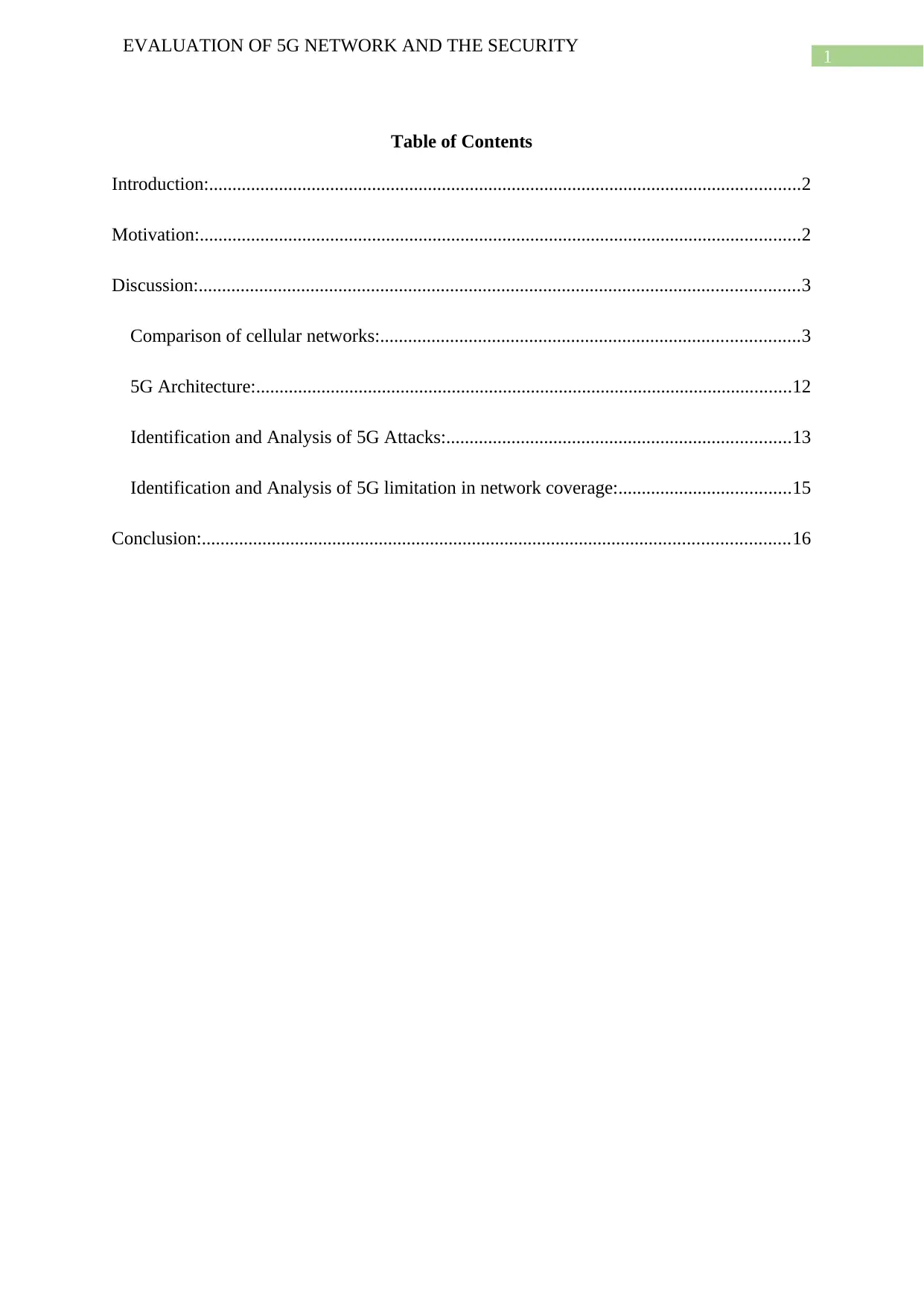
1
EVALUATION OF 5G NETWORK AND THE SECURITY
Table of Contents
Introduction:...............................................................................................................................2
Motivation:.................................................................................................................................2
Discussion:.................................................................................................................................3
Comparison of cellular networks:..........................................................................................3
5G Architecture:...................................................................................................................12
Identification and Analysis of 5G Attacks:..........................................................................13
Identification and Analysis of 5G limitation in network coverage:.....................................15
Conclusion:..............................................................................................................................16
EVALUATION OF 5G NETWORK AND THE SECURITY
Table of Contents
Introduction:...............................................................................................................................2
Motivation:.................................................................................................................................2
Discussion:.................................................................................................................................3
Comparison of cellular networks:..........................................................................................3
5G Architecture:...................................................................................................................12
Identification and Analysis of 5G Attacks:..........................................................................13
Identification and Analysis of 5G limitation in network coverage:.....................................15
Conclusion:..............................................................................................................................16
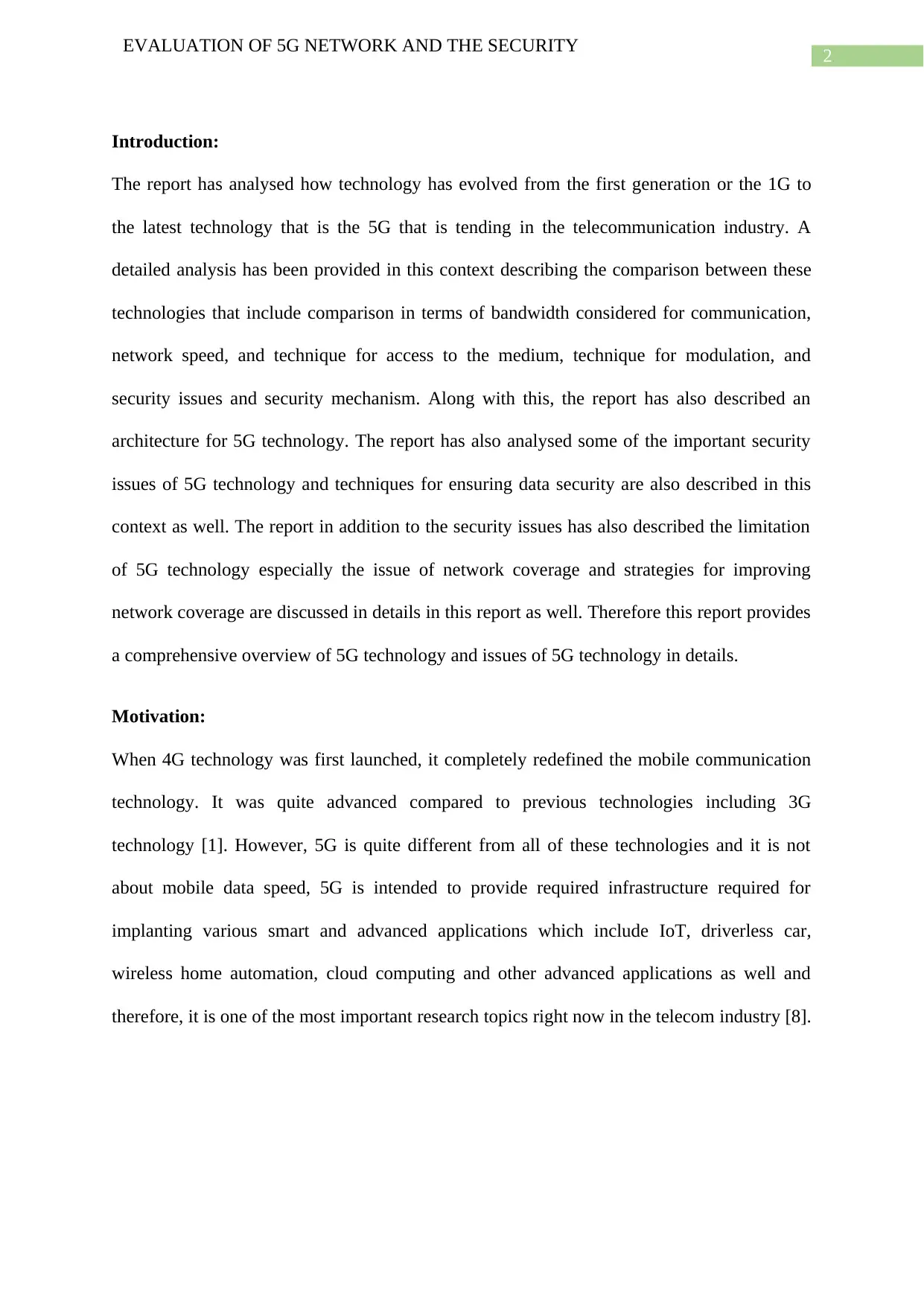
2
EVALUATION OF 5G NETWORK AND THE SECURITY
Introduction:
The report has analysed how technology has evolved from the first generation or the 1G to
the latest technology that is the 5G that is tending in the telecommunication industry. A
detailed analysis has been provided in this context describing the comparison between these
technologies that include comparison in terms of bandwidth considered for communication,
network speed, and technique for access to the medium, technique for modulation, and
security issues and security mechanism. Along with this, the report has also described an
architecture for 5G technology. The report has also analysed some of the important security
issues of 5G technology and techniques for ensuring data security are also described in this
context as well. The report in addition to the security issues has also described the limitation
of 5G technology especially the issue of network coverage and strategies for improving
network coverage are discussed in details in this report as well. Therefore this report provides
a comprehensive overview of 5G technology and issues of 5G technology in details.
Motivation:
When 4G technology was first launched, it completely redefined the mobile communication
technology. It was quite advanced compared to previous technologies including 3G
technology [1]. However, 5G is quite different from all of these technologies and it is not
about mobile data speed, 5G is intended to provide required infrastructure required for
implanting various smart and advanced applications which include IoT, driverless car,
wireless home automation, cloud computing and other advanced applications as well and
therefore, it is one of the most important research topics right now in the telecom industry [8].
EVALUATION OF 5G NETWORK AND THE SECURITY
Introduction:
The report has analysed how technology has evolved from the first generation or the 1G to
the latest technology that is the 5G that is tending in the telecommunication industry. A
detailed analysis has been provided in this context describing the comparison between these
technologies that include comparison in terms of bandwidth considered for communication,
network speed, and technique for access to the medium, technique for modulation, and
security issues and security mechanism. Along with this, the report has also described an
architecture for 5G technology. The report has also analysed some of the important security
issues of 5G technology and techniques for ensuring data security are also described in this
context as well. The report in addition to the security issues has also described the limitation
of 5G technology especially the issue of network coverage and strategies for improving
network coverage are discussed in details in this report as well. Therefore this report provides
a comprehensive overview of 5G technology and issues of 5G technology in details.
Motivation:
When 4G technology was first launched, it completely redefined the mobile communication
technology. It was quite advanced compared to previous technologies including 3G
technology [1]. However, 5G is quite different from all of these technologies and it is not
about mobile data speed, 5G is intended to provide required infrastructure required for
implanting various smart and advanced applications which include IoT, driverless car,
wireless home automation, cloud computing and other advanced applications as well and
therefore, it is one of the most important research topics right now in the telecom industry [8].
⊘ This is a preview!⊘
Do you want full access?
Subscribe today to unlock all pages.

Trusted by 1+ million students worldwide
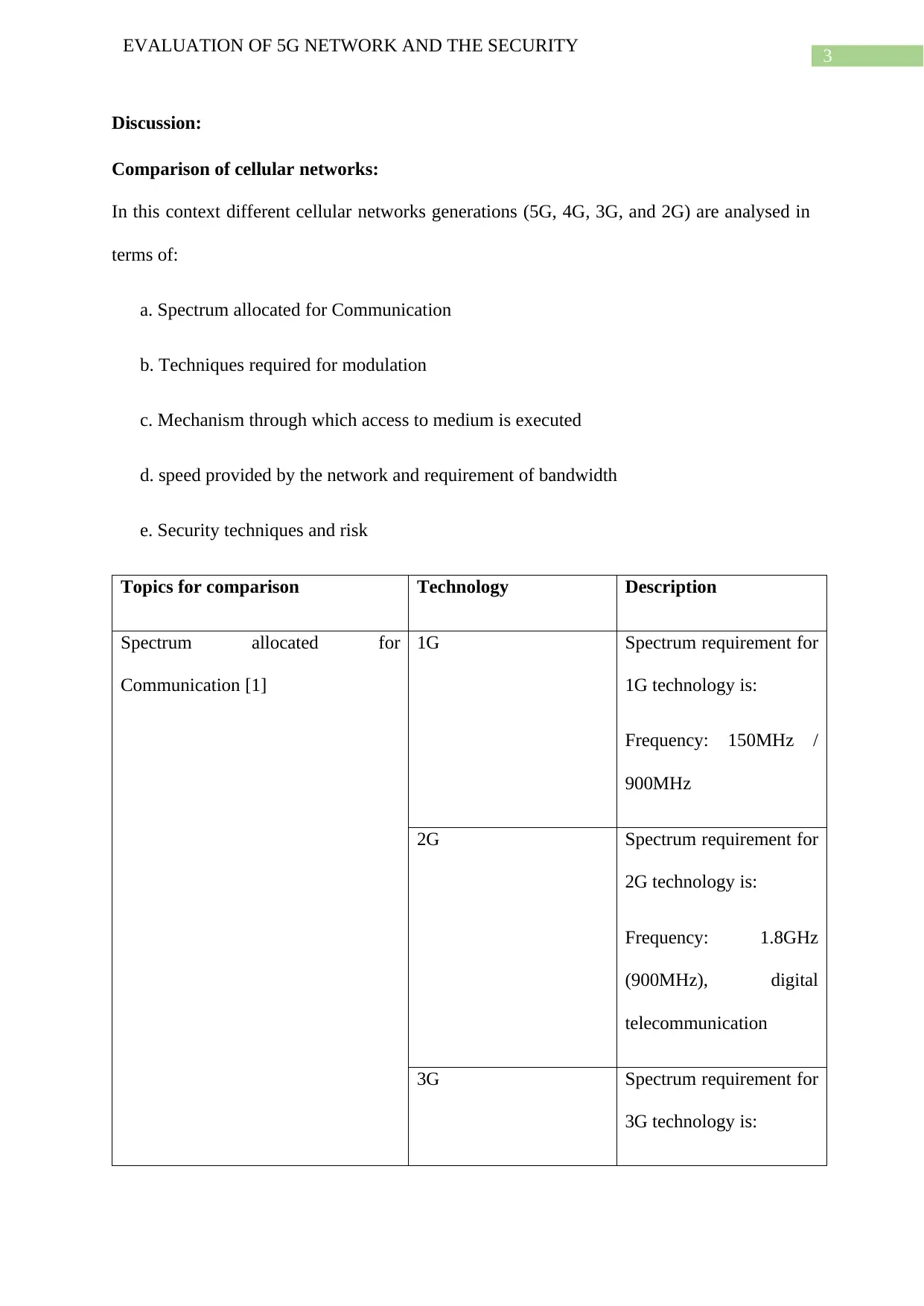
3
EVALUATION OF 5G NETWORK AND THE SECURITY
Discussion:
Comparison of cellular networks:
In this context different cellular networks generations (5G, 4G, 3G, and 2G) are analysed in
terms of:
a. Spectrum allocated for Communication
b. Techniques required for modulation
c. Mechanism through which access to medium is executed
d. speed provided by the network and requirement of bandwidth
e. Security techniques and risk
Topics for comparison Technology Description
Spectrum allocated for
Communication [1]
1G Spectrum requirement for
1G technology is:
Frequency: 150MHz /
900MHz
2G Spectrum requirement for
2G technology is:
Frequency: 1.8GHz
(900MHz), digital
telecommunication
3G Spectrum requirement for
3G technology is:
EVALUATION OF 5G NETWORK AND THE SECURITY
Discussion:
Comparison of cellular networks:
In this context different cellular networks generations (5G, 4G, 3G, and 2G) are analysed in
terms of:
a. Spectrum allocated for Communication
b. Techniques required for modulation
c. Mechanism through which access to medium is executed
d. speed provided by the network and requirement of bandwidth
e. Security techniques and risk
Topics for comparison Technology Description
Spectrum allocated for
Communication [1]
1G Spectrum requirement for
1G technology is:
Frequency: 150MHz /
900MHz
2G Spectrum requirement for
2G technology is:
Frequency: 1.8GHz
(900MHz), digital
telecommunication
3G Spectrum requirement for
3G technology is:
Paraphrase This Document
Need a fresh take? Get an instant paraphrase of this document with our AI Paraphraser
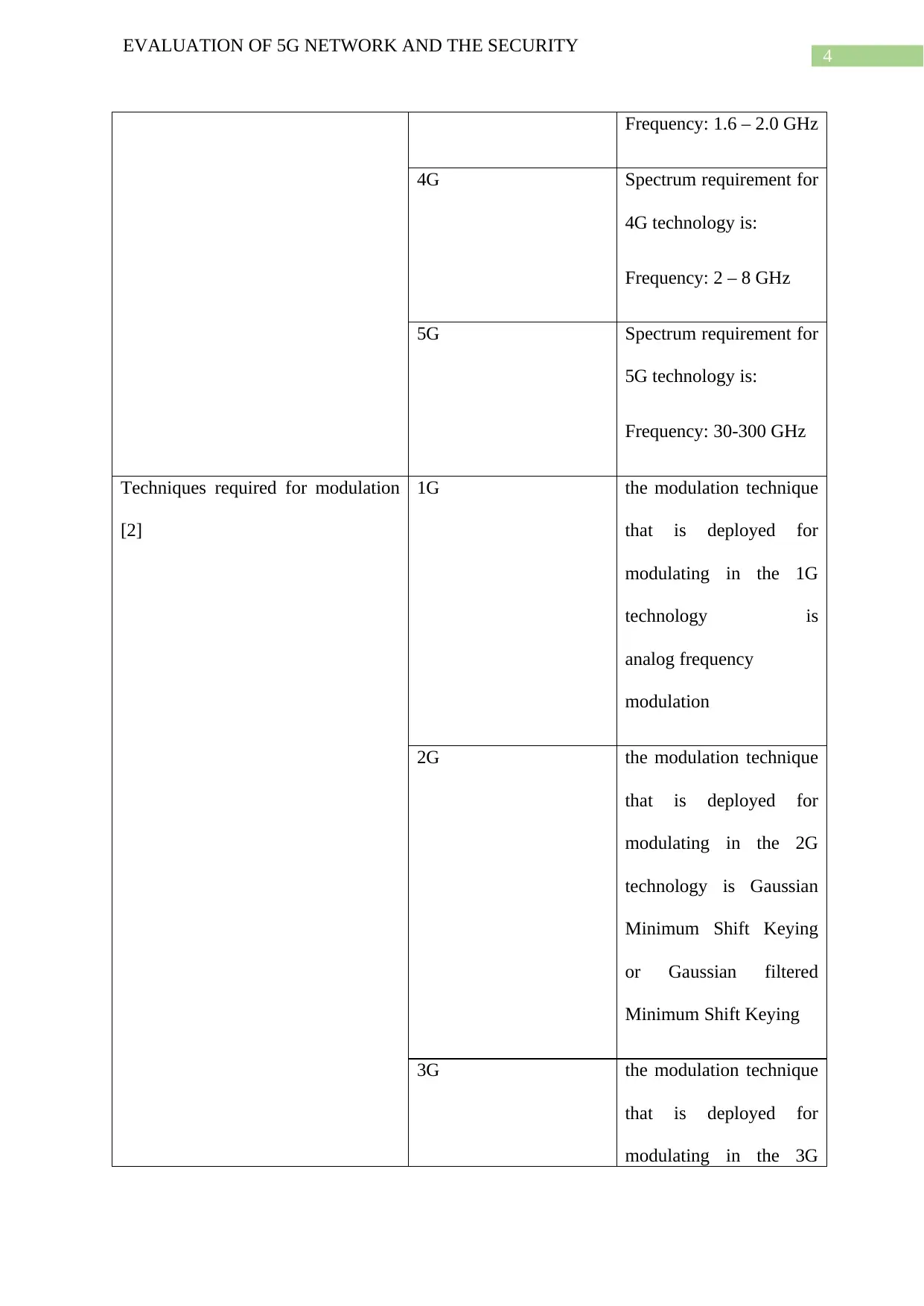
4
EVALUATION OF 5G NETWORK AND THE SECURITY
Frequency: 1.6 – 2.0 GHz
4G Spectrum requirement for
4G technology is:
Frequency: 2 – 8 GHz
5G Spectrum requirement for
5G technology is:
Frequency: 30-300 GHz
Techniques required for modulation
[2]
1G the modulation technique
that is deployed for
modulating in the 1G
technology is
analog frequency
modulation
2G the modulation technique
that is deployed for
modulating in the 2G
technology is Gaussian
Minimum Shift Keying
or Gaussian filtered
Minimum Shift Keying
3G the modulation technique
that is deployed for
modulating in the 3G
EVALUATION OF 5G NETWORK AND THE SECURITY
Frequency: 1.6 – 2.0 GHz
4G Spectrum requirement for
4G technology is:
Frequency: 2 – 8 GHz
5G Spectrum requirement for
5G technology is:
Frequency: 30-300 GHz
Techniques required for modulation
[2]
1G the modulation technique
that is deployed for
modulating in the 1G
technology is
analog frequency
modulation
2G the modulation technique
that is deployed for
modulating in the 2G
technology is Gaussian
Minimum Shift Keying
or Gaussian filtered
Minimum Shift Keying
3G the modulation technique
that is deployed for
modulating in the 3G

5
EVALUATION OF 5G NETWORK AND THE SECURITY
technology is
8PSK modulation scheme
4G the modulation
techniques that are
deployed for modulating
in the 4G technology are
phase-shift keying
(QPSK), 16-phase
quadrature amplitude
modulation (16QAM), or
64-state quadrature
amplitude modulation
(64QAM)
5G the modulation
techniques that are
deployed for modulating
in the 5G technology are
Filter Bank Multi-Carrier
(FBMC), Universal
Filtered Multi-Carrier
(UFMC), Generalized
Frequency Division
Multiplexing (GFDM),
Filtered OFDM (f-
EVALUATION OF 5G NETWORK AND THE SECURITY
technology is
8PSK modulation scheme
4G the modulation
techniques that are
deployed for modulating
in the 4G technology are
phase-shift keying
(QPSK), 16-phase
quadrature amplitude
modulation (16QAM), or
64-state quadrature
amplitude modulation
(64QAM)
5G the modulation
techniques that are
deployed for modulating
in the 5G technology are
Filter Bank Multi-Carrier
(FBMC), Universal
Filtered Multi-Carrier
(UFMC), Generalized
Frequency Division
Multiplexing (GFDM),
Filtered OFDM (f-
⊘ This is a preview!⊘
Do you want full access?
Subscribe today to unlock all pages.

Trusted by 1+ million students worldwide

6
EVALUATION OF 5G NETWORK AND THE SECURITY
OFDM)
Mechanism through which access to
medium is executed [3]
1G medium access control is
provided through the
frequency-division
multiple access (FDMA)
where the bandwidth that
is provided for the
communication is divided
into frequency bands
without any overlapping
2G medium access control is
provided through the
techniques which include
time-division multiple
access (TDMA) and
code-division multiple
access (CDMA)
3G medium access control is
provided through the
code-division multiple
access (CDMA)
4G medium access control is
provided through the
combination of multiple-
EVALUATION OF 5G NETWORK AND THE SECURITY
OFDM)
Mechanism through which access to
medium is executed [3]
1G medium access control is
provided through the
frequency-division
multiple access (FDMA)
where the bandwidth that
is provided for the
communication is divided
into frequency bands
without any overlapping
2G medium access control is
provided through the
techniques which include
time-division multiple
access (TDMA) and
code-division multiple
access (CDMA)
3G medium access control is
provided through the
code-division multiple
access (CDMA)
4G medium access control is
provided through the
combination of multiple-
Paraphrase This Document
Need a fresh take? Get an instant paraphrase of this document with our AI Paraphraser
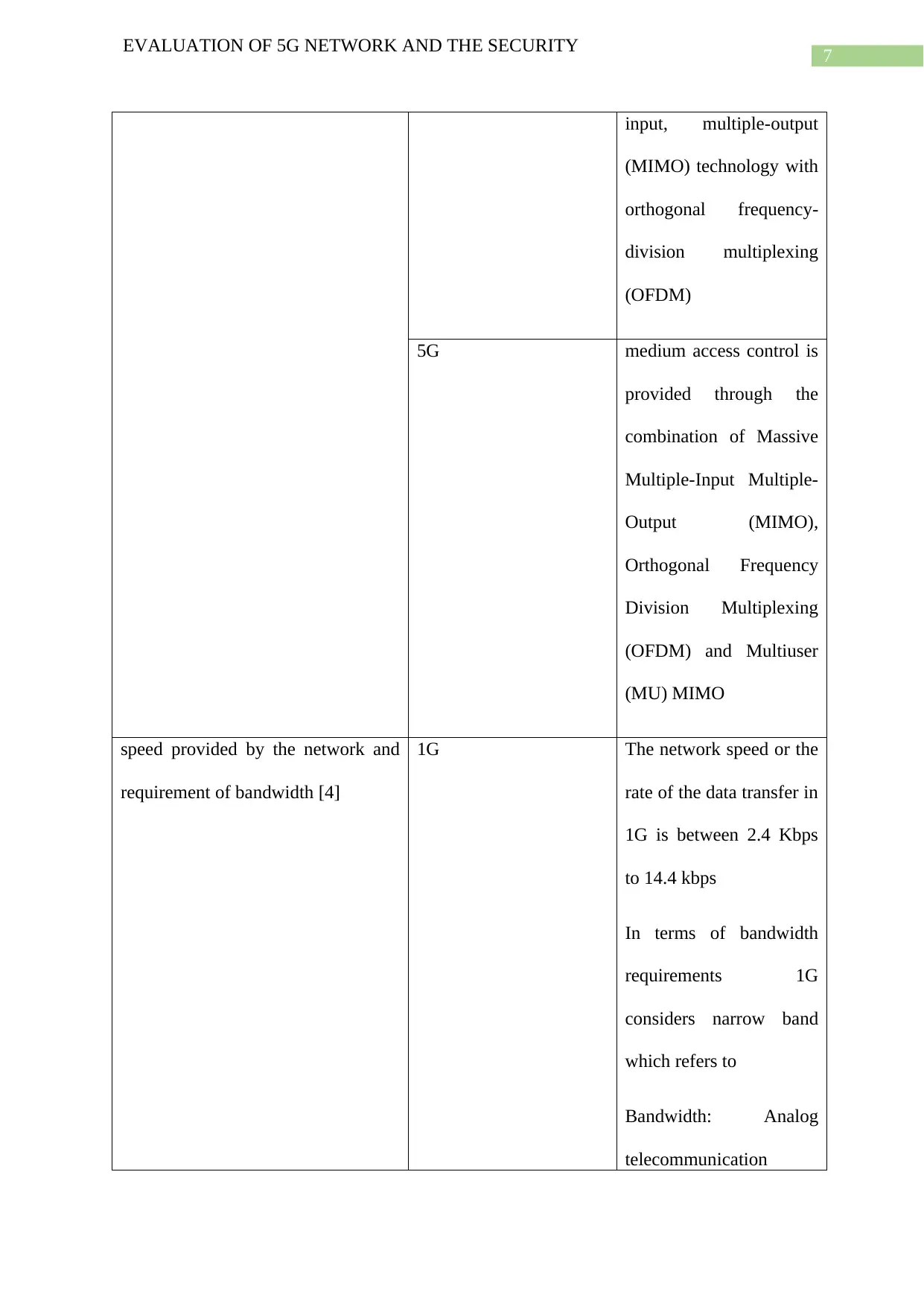
7
EVALUATION OF 5G NETWORK AND THE SECURITY
input, multiple-output
(MIMO) technology with
orthogonal frequency-
division multiplexing
(OFDM)
5G medium access control is
provided through the
combination of Massive
Multiple-Input Multiple-
Output (MIMO),
Orthogonal Frequency
Division Multiplexing
(OFDM) and Multiuser
(MU) MIMO
speed provided by the network and
requirement of bandwidth [4]
1G The network speed or the
rate of the data transfer in
1G is between 2.4 Kbps
to 14.4 kbps
In terms of bandwidth
requirements 1G
considers narrow band
which refers to
Bandwidth: Analog
telecommunication
EVALUATION OF 5G NETWORK AND THE SECURITY
input, multiple-output
(MIMO) technology with
orthogonal frequency-
division multiplexing
(OFDM)
5G medium access control is
provided through the
combination of Massive
Multiple-Input Multiple-
Output (MIMO),
Orthogonal Frequency
Division Multiplexing
(OFDM) and Multiuser
(MU) MIMO
speed provided by the network and
requirement of bandwidth [4]
1G The network speed or the
rate of the data transfer in
1G is between 2.4 Kbps
to 14.4 kbps
In terms of bandwidth
requirements 1G
considers narrow band
which refers to
Bandwidth: Analog
telecommunication
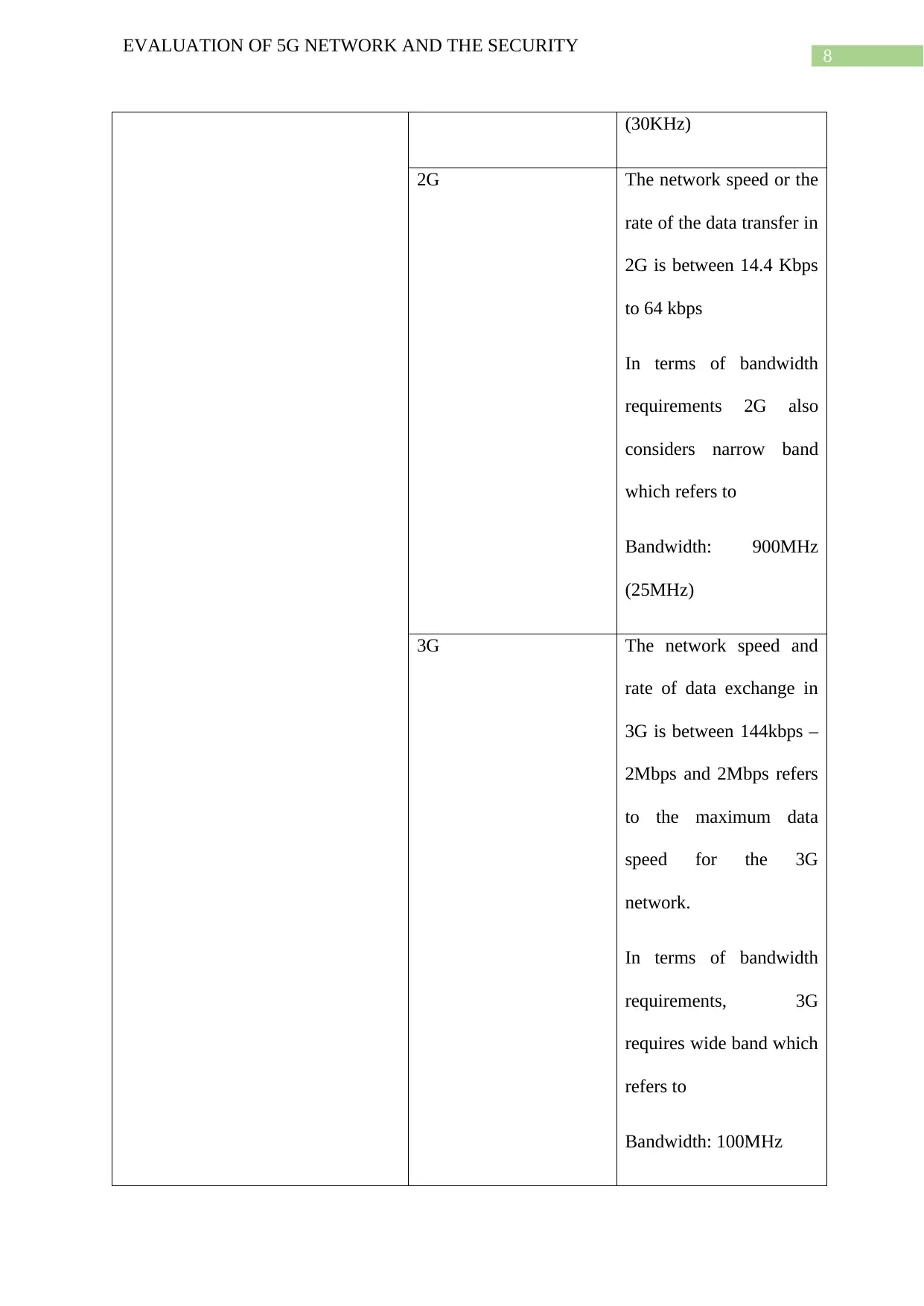
8
EVALUATION OF 5G NETWORK AND THE SECURITY
(30KHz)
2G The network speed or the
rate of the data transfer in
2G is between 14.4 Kbps
to 64 kbps
In terms of bandwidth
requirements 2G also
considers narrow band
which refers to
Bandwidth: 900MHz
(25MHz)
3G The network speed and
rate of data exchange in
3G is between 144kbps –
2Mbps and 2Mbps refers
to the maximum data
speed for the 3G
network.
In terms of bandwidth
requirements, 3G
requires wide band which
refers to
Bandwidth: 100MHz
EVALUATION OF 5G NETWORK AND THE SECURITY
(30KHz)
2G The network speed or the
rate of the data transfer in
2G is between 14.4 Kbps
to 64 kbps
In terms of bandwidth
requirements 2G also
considers narrow band
which refers to
Bandwidth: 900MHz
(25MHz)
3G The network speed and
rate of data exchange in
3G is between 144kbps –
2Mbps and 2Mbps refers
to the maximum data
speed for the 3G
network.
In terms of bandwidth
requirements, 3G
requires wide band which
refers to
Bandwidth: 100MHz
⊘ This is a preview!⊘
Do you want full access?
Subscribe today to unlock all pages.

Trusted by 1+ million students worldwide
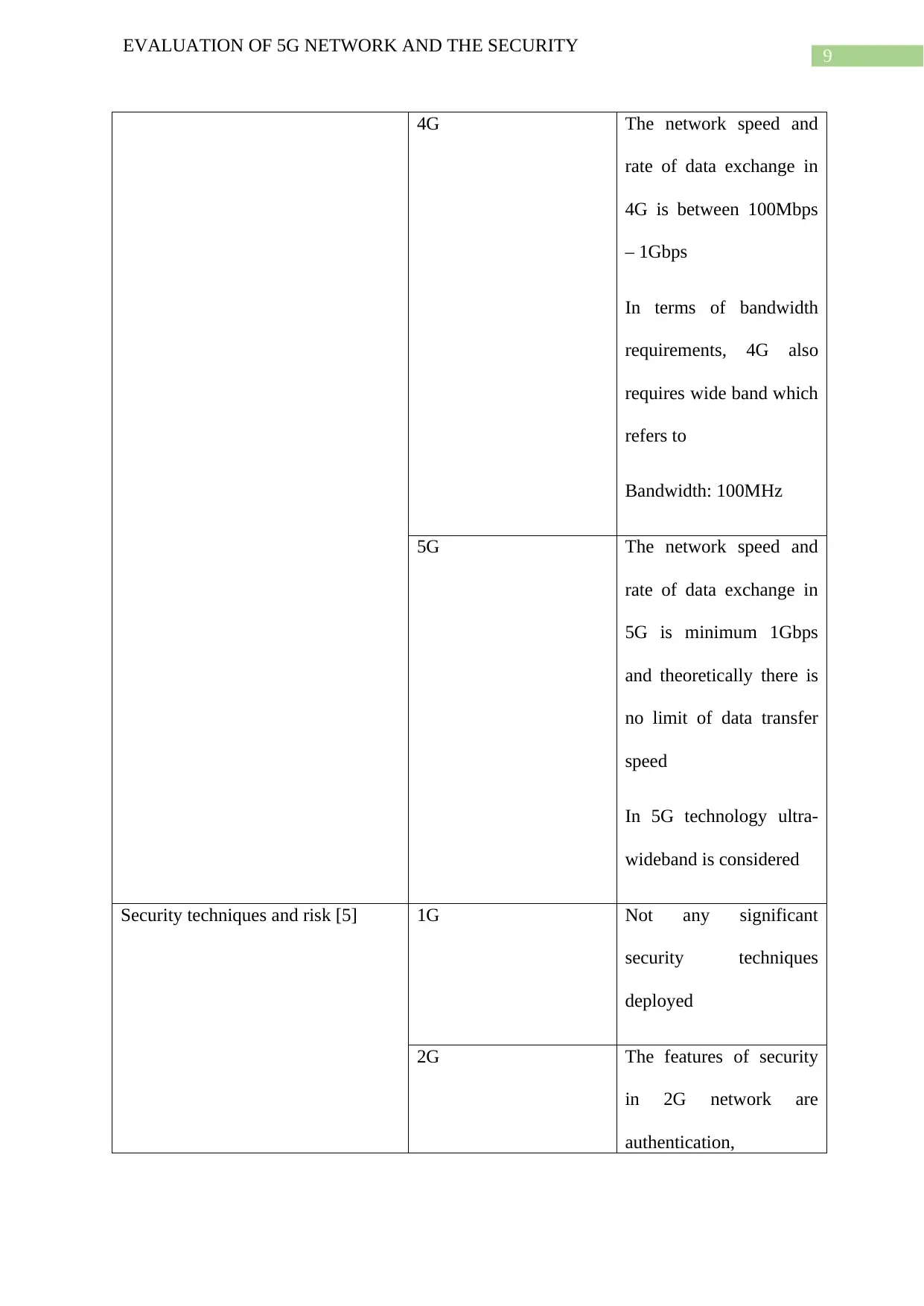
9
EVALUATION OF 5G NETWORK AND THE SECURITY
4G The network speed and
rate of data exchange in
4G is between 100Mbps
– 1Gbps
In terms of bandwidth
requirements, 4G also
requires wide band which
refers to
Bandwidth: 100MHz
5G The network speed and
rate of data exchange in
5G is minimum 1Gbps
and theoretically there is
no limit of data transfer
speed
In 5G technology ultra-
wideband is considered
Security techniques and risk [5] 1G Not any significant
security techniques
deployed
2G The features of security
in 2G network are
authentication,
EVALUATION OF 5G NETWORK AND THE SECURITY
4G The network speed and
rate of data exchange in
4G is between 100Mbps
– 1Gbps
In terms of bandwidth
requirements, 4G also
requires wide band which
refers to
Bandwidth: 100MHz
5G The network speed and
rate of data exchange in
5G is minimum 1Gbps
and theoretically there is
no limit of data transfer
speed
In 5G technology ultra-
wideband is considered
Security techniques and risk [5] 1G Not any significant
security techniques
deployed
2G The features of security
in 2G network are
authentication,
Paraphrase This Document
Need a fresh take? Get an instant paraphrase of this document with our AI Paraphraser
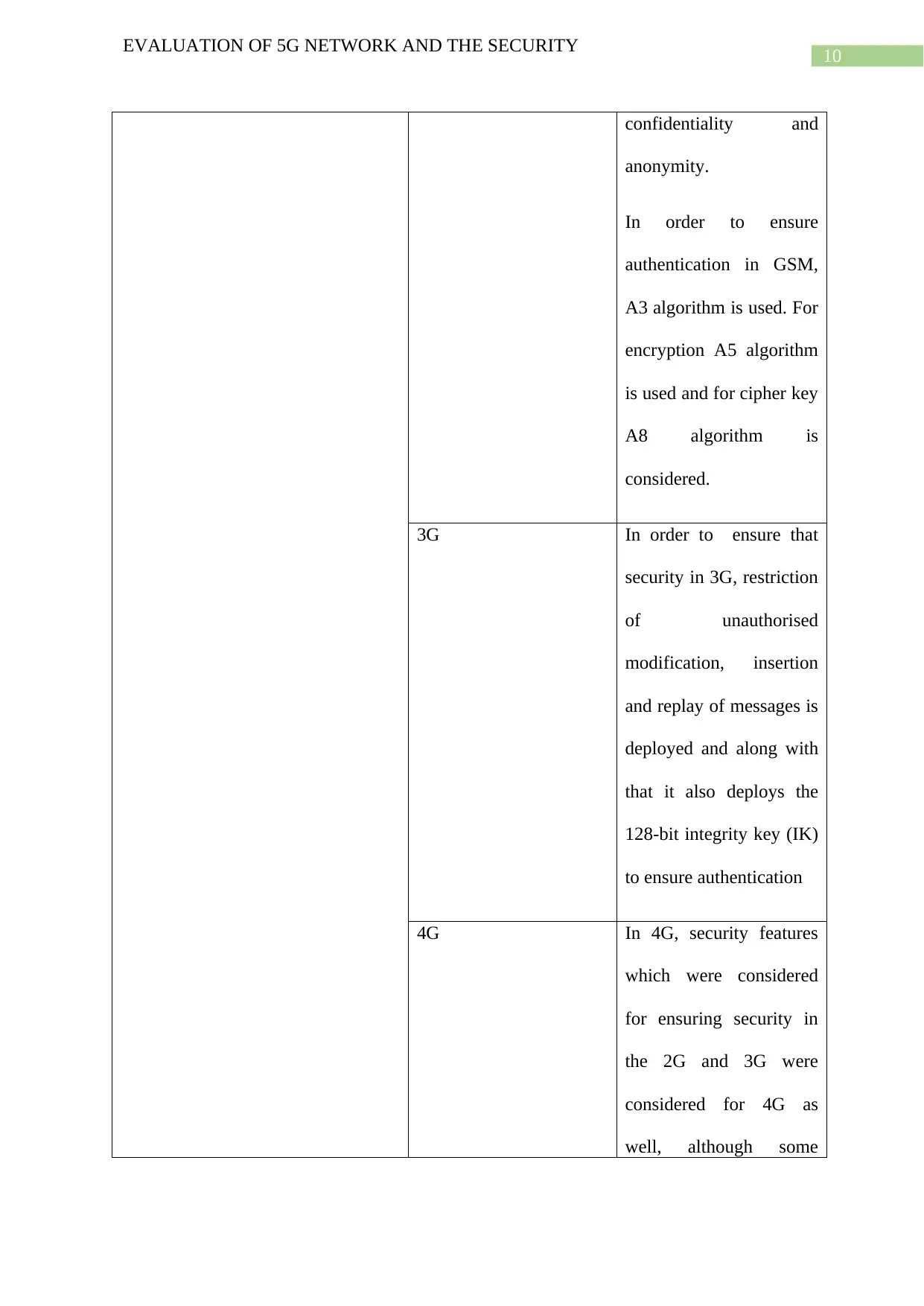
10
EVALUATION OF 5G NETWORK AND THE SECURITY
confidentiality and
anonymity.
In order to ensure
authentication in GSM,
A3 algorithm is used. For
encryption A5 algorithm
is used and for cipher key
A8 algorithm is
considered.
3G In order to ensure that
security in 3G, restriction
of unauthorised
modification, insertion
and replay of messages is
deployed and along with
that it also deploys the
128-bit integrity key (IK)
to ensure authentication
4G In 4G, security features
which were considered
for ensuring security in
the 2G and 3G were
considered for 4G as
well, although some
EVALUATION OF 5G NETWORK AND THE SECURITY
confidentiality and
anonymity.
In order to ensure
authentication in GSM,
A3 algorithm is used. For
encryption A5 algorithm
is used and for cipher key
A8 algorithm is
considered.
3G In order to ensure that
security in 3G, restriction
of unauthorised
modification, insertion
and replay of messages is
deployed and along with
that it also deploys the
128-bit integrity key (IK)
to ensure authentication
4G In 4G, security features
which were considered
for ensuring security in
the 2G and 3G were
considered for 4G as
well, although some
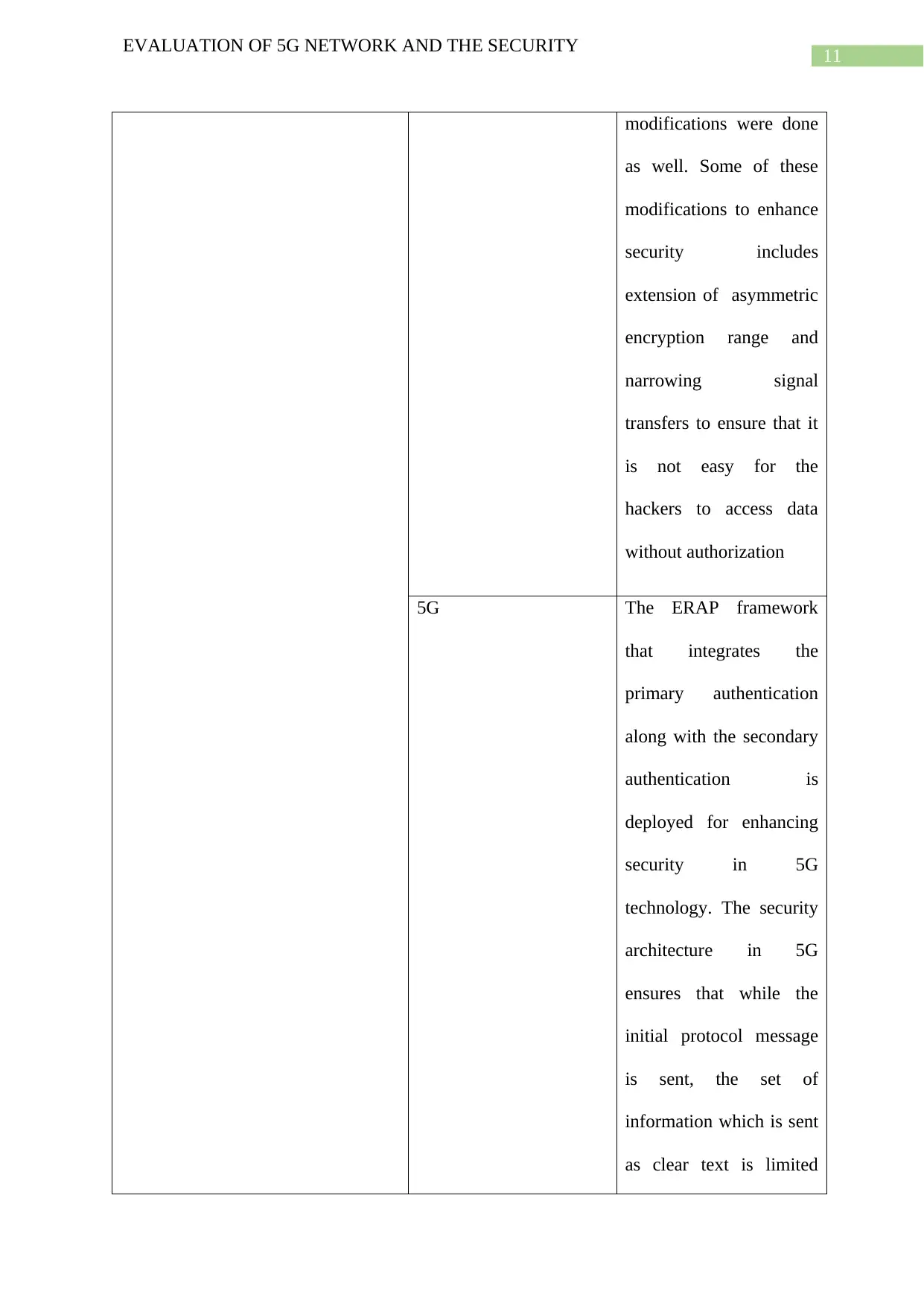
11
EVALUATION OF 5G NETWORK AND THE SECURITY
modifications were done
as well. Some of these
modifications to enhance
security includes
extension of asymmetric
encryption range and
narrowing signal
transfers to ensure that it
is not easy for the
hackers to access data
without authorization
5G The ERAP framework
that integrates the
primary authentication
along with the secondary
authentication is
deployed for enhancing
security in 5G
technology. The security
architecture in 5G
ensures that while the
initial protocol message
is sent, the set of
information which is sent
as clear text is limited
EVALUATION OF 5G NETWORK AND THE SECURITY
modifications were done
as well. Some of these
modifications to enhance
security includes
extension of asymmetric
encryption range and
narrowing signal
transfers to ensure that it
is not easy for the
hackers to access data
without authorization
5G The ERAP framework
that integrates the
primary authentication
along with the secondary
authentication is
deployed for enhancing
security in 5G
technology. The security
architecture in 5G
ensures that while the
initial protocol message
is sent, the set of
information which is sent
as clear text is limited
⊘ This is a preview!⊘
Do you want full access?
Subscribe today to unlock all pages.

Trusted by 1+ million students worldwide
1 out of 20
Related Documents
Your All-in-One AI-Powered Toolkit for Academic Success.
+13062052269
info@desklib.com
Available 24*7 on WhatsApp / Email
![[object Object]](/_next/static/media/star-bottom.7253800d.svg)
Unlock your academic potential
Copyright © 2020–2025 A2Z Services. All Rights Reserved. Developed and managed by ZUCOL.





